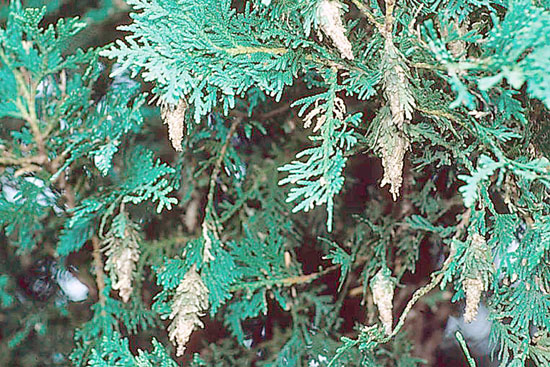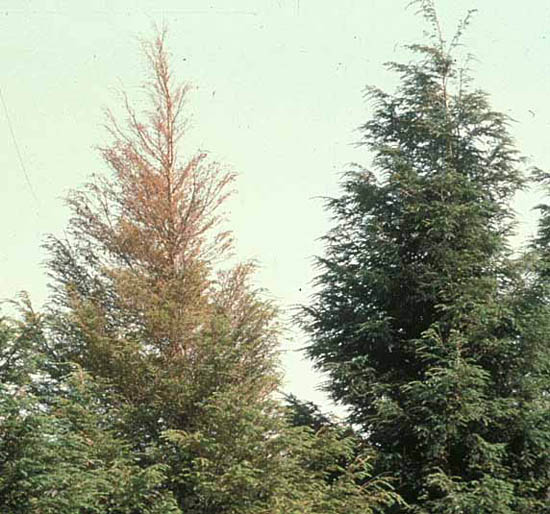Issue 9, June 19, 2009
Bagworm
As was reported in last week’s newsletter, it appears that the bagworm eggs may have been killed by severe winter temperatures in central and northern Illinois. Before treating, be sure to scout for young caterpillars. Egg hatch was probably normal in southern Illinois, and treatment is recommended on trees with large populations. Ballooning by young larvae should be ending in southern Illinois at this time, allowing one spray application to be sufficient to provide control.
Bagworms live in individual silk tents, or bags, that they cover with pieces of the foliage that they are feeding upon. The bags are spindle-shaped and vary from one to two inches long. Eggs overwinter in the females' bags that hang on the tree throughout the winter, tied to their branches with many loops of silk. The eggs hatch when catalpa blooms, which occurred a week ago in central Illinois.

The newly hatched larvae crawl out of the bottom of their mother's bag and crawl to the top of trees. The tiny caterpillars almost immediately spin tiny bags and cover them with bits of foliage or anything else that they can find. They spin out strands of silk two to three feet long and swing on the ends of them. Wind gusts break them loose and they drift on the wind. This is called ballooning. Updrafts can keep them aloft for very long distances.
Being carried on the wind, they have no choice of food plants as their only options are to feed on the plant that they land upon or crawl to the top and balloon again. This process lasts for about two weeks after egg hatch. As a result, they feed on many trees and shrubs, being most common on arborvitae, Eastern red cedar, other junipers, spruce, Eastern white pine, crabapple, cherry, and oak.
Bagworms start to feed at the top of the tree and work their way down. They protrude the front end of their bodies out of the bag to feed, using their true legs to drag themselves and their bags around the tree. They have dark heads and whitish bodies with dark spots. The larvae feed on deciduous leaves from the margins inward, sometimes eating the entire lamina, leaving only the midvein. Needles on evergreens are eaten from the tip to the base. Needled evergreen branches stripped of foliage will usually die, and entire trees can be killed by heavy infestations. Deciduous hosts will refoliate stripped branches, even entire trees.

Fully-grown bagworms pupate within their bags in late summer, typically between mid-August and early September. Male moths are about one inch long and black with clear wings. They emerge through the bottom of the bag, frequently pulling their pupal skins out of the bag as they emerge in the fall. The females emerge within the bag as larvaform adults, being dark reddish-brown and caterpillar-like. The male moths fly between female bags, mating with the females through the bottom of the bag. Male moths die within a few days, having no functional mouthparts and being unable to feed. Mated females fill their bodies with 300 to 1000 eggs and die.
Bagworms can be controlled by hand-picking the bags from fall into early June and destroying them. With approximately a one to one sex ratio, every other bag will contain an egg-filled female. Hand-picking is effective on shrubs and small trees, but most bags are not reachable on taller trees.
Insecticide spraying should be delayed for two weeks after egg hatch to allow ballooning to end. This allows control to be achieved with only one application. Bacillus thuringiensis kurstaki (Dipel, Thuricide) is very effective except on older caterpillars. Spinosad (Conserve), cyfluthrin (Tempo), permethrin (Astro), bifenthrin (Onyx, Talstar), and other pyrethroids also provide effective control.--Phil Nixon
Author:
Phil Nixon